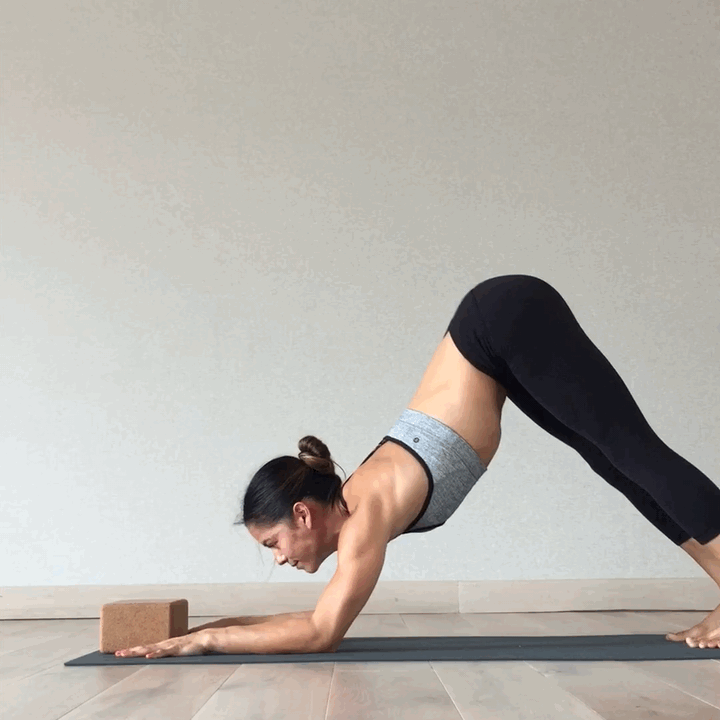PINCHA MAYURASANA
Prepare your body for forearm stand by practicing these exercises at home.
To balance on your forearms safely and easily our goal is to align elbows directly under shoulders, hips and heels. In order for that to happen, we must stretch and strengthen the shoulders, which takes time. Like all good things, discipline and hard work payoff in the most rewarding ways. Remember, it's not about the end goal, it's what you discover along the journey.
Practice this stretch every day in any place:
Here I have two blocks side-by-side on their medium setting. But you could easily achieve this stretch by resting your elbows on the kitchen counter while waiting for your morning coffee.
Start by placing your elbows shoulder-distance apart. Bring your palms together and let your head hang. Notice how your ribs extend forward when arms are overhead. Isolate the stretch in your shoulders by neutralizing your spine; hug your bottom ribs in and lengthen your lower back. Hold for 10 breaths.
If your elbows slide apart extend your arms to rest your palms on the counter/block instead.
To keep your elbows in place, try this next:
A major challenge with forearm stand is maintaining alignment of elbows under shoulders. Once the weight of the body comes into play gravity presses us down and elbows splay out. To counter that we must strengthen the chest + outer shoulders and cultivate the opposite: squeeze in to go up!
Start with a block or anything you can hold easily that matches the width of your shoulders. Firmly place your palms on either end and press inwards to feel your chest muscles activate (pectoralis major + minor). Extend your arms overhead without your ribs flaring forward then relax your shoulders. Bend your elbows in towards one another and pause at shoulder height. As you hug your elbows together notice the tone alongside your ribcage (latissimus dorsi) and on the underside of your upper-arm bone (teres major attaches to the humerus). Keeping that engagement, begin to re-extend your arms overhead and imagine two magnets attracting your elbows together until they're completely straight. Repeat 10 times.
Ok we got the in, how about the up?
I know this looks creepy at first, but when you stare at it long enough you can see my shoulder blades spread apart and "wrap" around my rib cage, lifting my chest away from the floor. This protraction and retraction exercise will strengthen the muscles between the blades (rhomboids) and bring lightness to your inversion practice, it will also help your posture and reduce back pain.
Try this in forearm plank with a block pressed between your thumbs and index fingers. Fan your fingers wide and see if your wrists align with your elbows and shoulders. You might need two blocks (of any configuration) to accommodate broad shoulders. Pressing into the block keeps the hands from moving together and thus the elbows from moving apart.
Roll your shoulders down your back and plug your bottom ribs in. Extend your legs and activate quadriceps and hug thigh bones together. Exhale and press into your forearms to dome your upper back (protract scapula). Inhale and squeeze your shoulder blades together on your back (retract scapula). Keep moving with your breath while maintaining a neutral spine and hips. 15 reps.
Build strength to float into forearm stand with this exercise:
I call these "pincha push-ups." Your chaturanga push-up strengthens triceps, which act as a stabilizer in this exercise, as they do in forearm stand. When shifting from dolphin pose to pincha mayurasana we also shift the center of gravity forward to help counter the weight of legs lifting overhead. As this happens, the shoulders dip forward and you have to be able to press back up or, face-plant (trust me, this will happen plenty of times, as it should). Practicing these pincha push-ups will strengthen the meaty muscle at the top of your arm (deltoid) so you can bounce back.
Keep the same set-up of your arms from the previous exercise and lift your hips like downward dog. Enjoy a few breaths pressing your chest back toward your thighs, find a line from your elbows to your hips and relax your head. Look up at the block and exhale as you tap your nose, inhale and press back. Repeat 10 times.
Practice these daily and by the end of June you'll be ready to try pincha mayurasana!
Need props for your home practice? As an ambassador for Manduka Yoga, I can offer you a promo code for 20% off! Contact me and I'll send you a personalized one.





